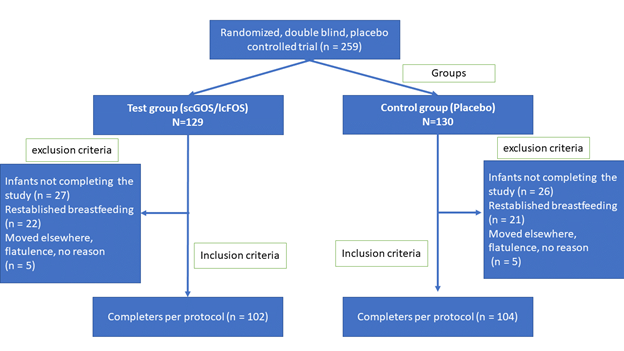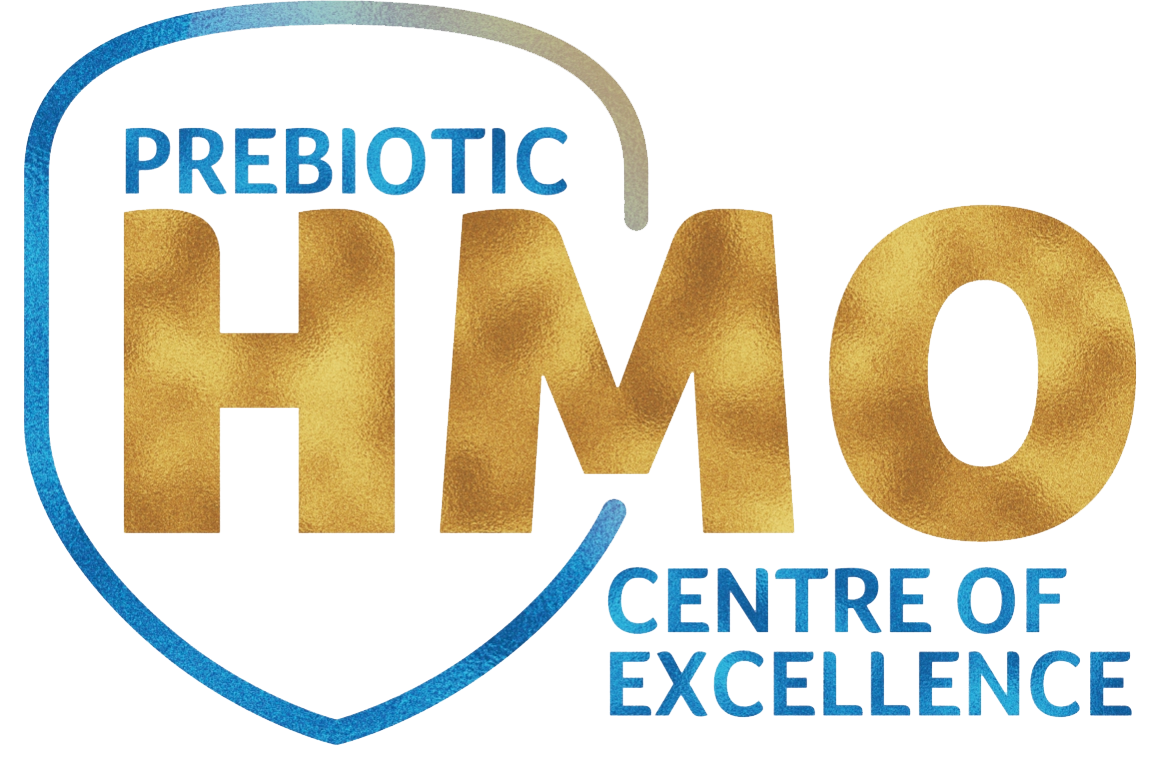Early Prebiotic Supplementation Prevents Infection in Formula-Fed Infants
Human breastmilk has a preventive effect against infections and related morbidity and mortality due to various bioactive components and its prebiotic effect on the gut microflora. This Clinical Summary elucidates how the prebiotic feed supplements can similarly have a positive impact on the infants’ immune system development.
Background
Gut microflora with a larger number of bifidobacteria and lactobacilli and lesser pathogenic microbes holds the primary importance in developing the immune system. Human milk oligosaccharides (HMOs), such as short-chain galactooligosaccharides (scGOS) and long-chain fructooligosaccharides (lcFOS) in the ratio 9:1 have been shown to have excellent prebiotic effects. The feed supplementation containing these components helps develop intestinal microflora similar to that found in breast-fed infants.
Objective
To test the hypothesis that the prebiotic scGOS/lcFOS mixture could prevent infections for the first 6 months of life by modifications in the intestinal flora.
Study design
The entire study design is as shown in the flowchart Figure 1. The study was conducted over 2 years span to rectify any seasonal variations.

Fig. 1 Study design for the randomized double-blind intervention
Parameters assessed:
- Growth (weight, length, and head circumference)
- Infectious episodes of all types (overall, upper respiratory tract infections (URTI), otitis media, gastrointestinal infections, and urinary tract infections (UTI))
- Gut microbiota analysis
Outcome assessed
- Number of documented infectious episodes of all types;
- Infectious episodes requiring antibiotic treatment;
- Cumulative number of 1 or more infectious episodes in the entire study population;
- Number of events of infectious episodes over time
Results
- During the 6-months study, scGOS/lcFOS fed infants demonstrated fewer episodes of all infection types (P = 0.01). They also had fewer URTI episodes (P = 0.07) (Figure 2).

Fig. 2 Infections incidences (cumulative) during the first 6 months of life in the test group and control group (*P = 0.05, **P = 0.01) .
2. Infections demanding antibiotic treatments were lesser in number in scGOS/lcFOS fed infants (11 episodes) than ones in the placebo group (22 episodes; P = 0.10) (Figure 3).

Fig. 3 Incidence of infections in the test and control groups compared over time (*Different from scGOS/ lcFOS, P < 0.05).
3. Infants fed with ScGOS/lcFOS had lesser incidences of at least 1 episode of any infection, recurrent infections (≥2 episodes of any infection), and recurring URTIs as compared to the placebo group (P = 0.05).
4. Infants aged 4-6 months had fewer incidences of infections in the scGOS/lcFOS group than in the placebo group (P = 0.05).
5. Supplementation with scGOS/lcFOS significantly increased bifidobacteria count (10.3 vs. 8.7; P = 0.0001) compared to the placebo group.
Conclusion
scGOS/lcFOS; 9:1 positively modulates immunity in early life. However, the the specific mechanism underlying the immunoprotective role is unclear.
References:
- Arslanoglu S, Moro GE, Boehm G. Early supplementation of prebiotic oligosaccharides protects formula-fed infants against infections during the first 6 months of life. The Journal of nutrition. 2007 Nov 1;137(11):2420-4.
IMPORTANT NOTICE:
MOTHER’S MILK IS BEST FOR YOUR BABY
The World Health Organization (WHO)* has recommended that pregnant women and new mothers be informed of the benefits and superiority of breast-feeding, in particular, the fact that it provides the best nutrition and protection from illness for babies. Mothers should be given guidance on the preparation for and maintenance of lactation, with special emphasis on the importance of the well-balanced diet both during pregnancy and after delivery. Unnecessary introduction of partial bottle feeding, or other foods and drinks should be discouraged since it will have a negative effect on breast-feeding. Similarly, mothers should be warned of the difficulty of reversing a decision not to breastfeed. Before advising a mother to use an infant formula, she should be advised of the social and financial implications of her decision. For example, if a baby is exclusively bottle-fed, more than one can (500g) per week will be needed, so the family circumstances and cost should be kept in mind. Mother should be reminded that breast milk is not only the best but also the most economical food for babies. If a decision to use infant formula is taken, it is important to give instruction on correct preparation methods, emphasizing that unboiled water, unsterilized bottles or incorrect dilution can lead to illness.
*See: International Code of Marketing of Breast Milk Substitutes, adopted by the World Health Assembly in Resolution WHA 34.22, May 1981.
Importance of Breastfeeding:
(i) Immediately after delivery, breast milk is yellowish and sticky. This milk is called colostrum, which is secreted during the first week of delivery. Colostrum is more nutritious than mature milk because it contains more protein, more anti-infective properties which are of great importance for the infant's defense against dangerous neonatal infections. It also contains higher levels of, Vitamin 'A', (ii) breast miIk- A) is, a complete and balanced food and provides all the nutrients needed by the infant [for the first six months of life] (B) has anti-infective properties that protect the infants from infection in the early months (C) is always available; (D) needs no utensils or water (which might, carry germs) or fuel for its preparation, (iii) breastfeeding is much cheaper than feeding infant milk substitutes as the cost of the extra food needed by the mother is negligible compared to the cost of feeding infant milk substitutes, (iv) mothers who breast-feed usually have longer periods of infertility after child birth than non-lactators; (b) details of management of breast feeding, as under:- (i) breast-feeding- (A) immediately after delivery enables the contraction of the womb and helps the mother to regain her -figure quickly; (B) is successful when the infant suckles frequently and the mother wanting to breast-feed is confident in her ability to do so (ii) in order to promote and support breast-feeding the mother’s natural desire to breast feed should always be encouraged by giving, where needed, practical advice and making sure that she has the support of her relatives. (iii) adequate care for the breast and nipples should be taken during pregnancy. (iv) it is also necessary to put the infant to the breast as soon as possible after delivery, (v) let the mother and the infant stay together after the delivery, the mother and her infant should be allowed to stay together (in hospital, this is called "rooming-in"); (vi) give the infant colostrum as it is rich in many nutrients and anti-infective factors protecting the infants from infections during the few days of its birth; (vii) the practice of discarding colostrum and giving sugar water, honey water, butter or other concoctions instead of colostrum should be very strongly discouraged; (viii) let the infants suckle on demand; (ix) every effort should be made to breast-feed the infants whenever they cry; (x) mother should keep her body and clothes and that of the infant always neat and clean.
Breast-feeding is the best form of nutrition for babies and provides many benefits to babies and mothers. It is important that, in preparation for and during breast-feeding, you eat a healthy, balanced diet. Combined breast and bottle-feeding in the first weeks of life may reduce the supply of your own breast-milk and reversing the decision not to breast-feed is difficult.
Always consult your Healthcare Professional for advice about feeding your baby. The social and financial implications of using infant formula should be considered. Improper use of an infant formula or inappropriate foods or feeding methods may present a health hazard. If you use infant formula, you should follow manufacturer's instructions for use carefully - failure to follow the instructions may make your baby ill.
Published by:
Nutricia International Private Limited
Building A, unit no. 304, 3rd Floor,
Agastya Corporate Park, Kamani Junction,
L.B.S. Marg, Opp. Fire Brigade,
Kurla (West), Mumbai 400070
CVM code: 1620237289726


